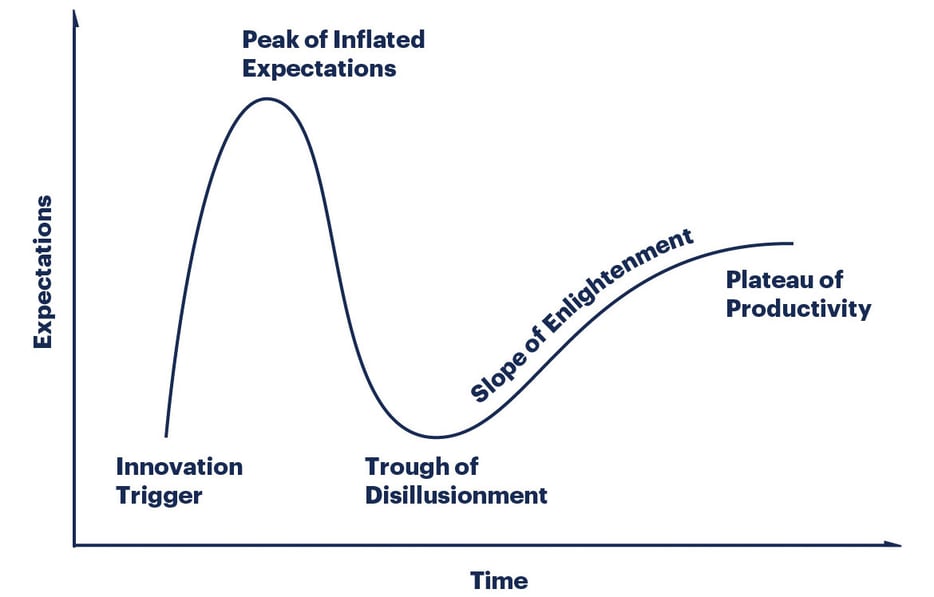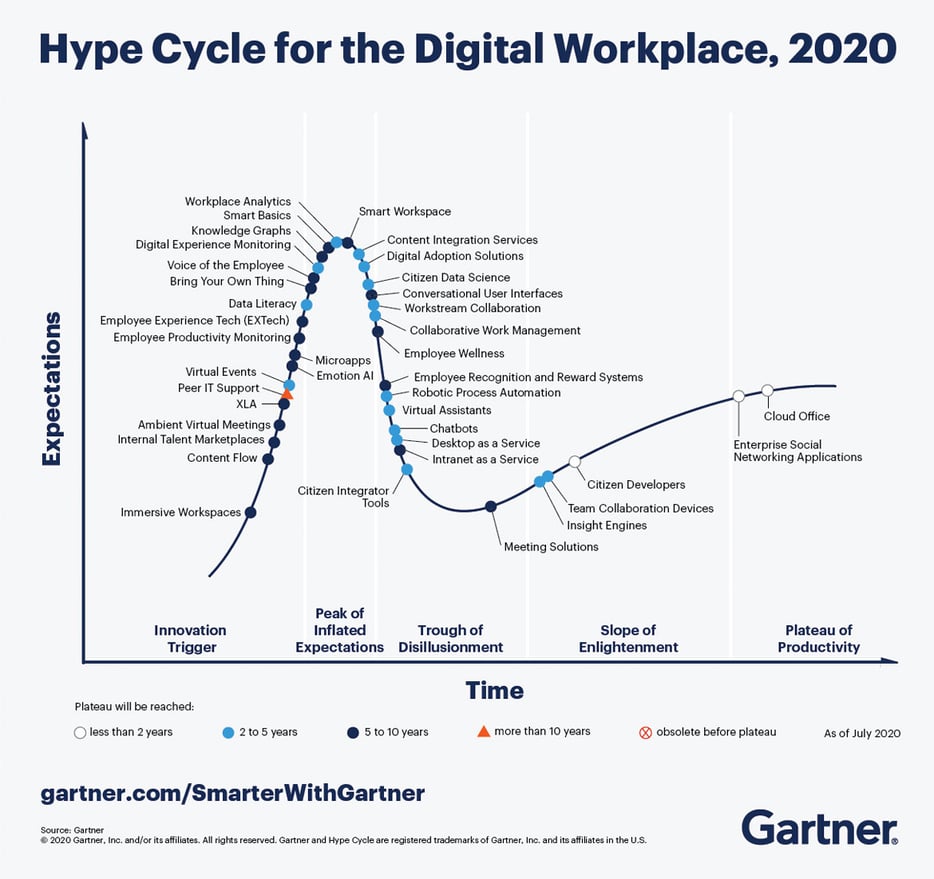Gartner’s new Hype Cycle – the Digital Workplace Roller Coaster

Gartner’s Hype Cycles and Magic Quadrants tend to generate lively discussions among those who work at the ‘coal face’. The latest Hype Cycle that relates to the Digital Workplace is certainly no exception.
What is a Hype Cycle?
A Hype Cycle charts the arrival of new technologies and follows their progress on the same roller coaster ride. We start with a period of initial excitement and high expectations, then move on to a gradual descent into the ‘Trough of Disillusionment’ when consumers realise the technology doesn’t quite live up to everything promised in the build-up, and finally through to a steady plateau where it, at last, generates solid business value.

The rise or fall of email?
For those who follow these trends over a number of years, it’s always interesting to see what technology is rising or falling in favour on its pre-meditated journey along the curve.
Take e-mail, for example. At one point its total demise was predicted, (“e-mail is dead already” said many). Now it’s bundled in as Cloud Office with a range of associated tools and a big future ahead.
This latest Hype Cycle takes into account the massive impact of COVID-19 on digital workplace change and adoption. In the case of Zoom and Teams video calls, the uptake has been dramatic and rapid. In other instances, such as the replacement of older ways of collaborating with more social tools, the uptake has been slower and somewhat fragmented.
Predicting where this will take us in the future is tricky, of course, but there are some clear identifiable trends.

Six key trends
Before we take a look at a few of the points on the new roller coaster in more detail., let’s see what Gartner have released in terms of analysis.
They have identified 6 Trends on the Gartner Hype Cycle, many of these have been covered in previous Resonate blogs.
The first of these trends is the growing importance of what they call the ‘new work nucleus’ – the collection of ‘SaaS-based personal productivity, collaboration and communication tools’ that most of us think of as Office 365, e-mail and Teams.
Next, they identify that we’re all bringing a variety of gadgets into work – smartphones, tablets, fitness bands and even, they predict, robots and drones. This echoes one of the Digital Workplace Group’s themes in their Decade of Courage Manifesto, which grandly refers to the ‘distance economy’, better known to most of us as working from home! This has been extensively commented on over the last few months, with the long-term trend now accelerating faster than ever as a result of the impact of COVID-19.
Old wine in new bottles?
Gartner also say the pandemic has given rise to new meeting solutions, but that’s somewhat moot. Those solutions were mostly here before; what’s new is their widespread use.
Similarly, they pinpoint ‘Smart workplaces’ as being novel but, apart from face recognition, much of this technology has been around for some time. Digital signage is already widely used, as are motion sensors. (Many of us have experienced the irritation of an office going dark and having to wave our arms around to turn the lights back on.)
‘Desktop-as-a-service’, otherwise known as the virtual desktop, is not exactly new either. But Gartner are probably correct when they say this will increase in popularity as people return to the office.
As a side note, I’m very keen to experience the predicted ‘Ambient Virtual Meeting’ and whether we will be getting similarly ambient virtual offices.
Democratized technology services
The final trend is called ‘democratized technology services’. This is the ability for people who use tools and services to actually build and manage them. The term they use is ‘Citizen developers’, a theme I explored in a previous Resonate blog “We can fix that!”.
Alongside the citizen developer, we also have the ‘Citizen data scientist’. That’s because, with analytics solutions such as Microsoft’s Power BI, it’s now much easier to extract meaningful readable data and reports from complex, and often disparate, databases.
Accelerating and Converging Trends
Taking a closer look at some of the detail on the roller coaster, we can see that long-standing trends have both accelerated and converged. What might have been standalone solutions once are now available as a package of services – Office, now Microsoft 365, being the most obvious example.
We can also see that chatbots are on a downward curve. This Is probably because, in some companies, far too many have been made and their novelty is beginning to wear thin. Most of us have experienced the irritation of chatbots coming back with obscure answers that have no bearing on the question. Shades of Mr Paperclip, perhaps, for those with longer memories.
Intranets and Enterprise Social Networks
What’s perhaps most of interest and has generated the most discussion on platforms such as LinkedIn, is the placing of Collaborative Work and Collaborative workstreams, Intranet as a Service and Enterprise Social Networking Applications, sometimes known as ESNs – e.g. Yammer, Slack and Jive. Collaborative working is set the decline in expectation and hype.
The intranet is near the bottom of the slope, heading right into the trough, whereas ESNs are in the sunny plain of productivity. This seems odd as the one thing we’ve seen more than any other over the last few months is the rapid roll-out of collaborative tools such as Teams.
The Plateau of Productivity
Perhaps the disillusionment with collaboration is down to the fact that tools such as Microsoft Teams are only being partly used – real-time collaboration prevailing over asynchronous work.
Similarly, intranets could be heading south as Teams has made them less central to many digital workplaces, though arguably this is where they need to be [Link to SharePoint blog when published].
Finally, if ESNs are in the productivity phase, alongside the Cloud Office, this is to be welcomed. Getting hard data on their performance, however, has been something of the ‘Holy Grail’ over recent years and it’s still not readily available. That said, it does look like Intranets and Enterprise Social Networks are both currently demonstrating tangible business benefits.
Join Resonate on the Digital Workplace rollercoaster ride
How things will have changed by the time the next Hype Cycle is released, say in 2022 when hopefully life will have returned to some level of normality, will be revealing. One thing is certain: the cycle is moving faster than before and changes are now happening at a breakneck speed that we’re simply not used to.
At Resonate, we’re equipped to make the Digital Workplace Rollercoaster less scary for you. Please watch out for future Resonate webinars where we will explore how new solutions are changing the way we all work, and how we can help you deploy, change and adopt the workplace of the future.
More like this
 How to Build a Centre of Excellence for Digital Transformation - 1
How to Build a Centre of Excellence for Digital Transformation - 1
 Using apps to create an Ecosystem within Microsoft Teams - 2
Using apps to create an Ecosystem within Microsoft Teams - 2
 Creating an Agile Environment with Apps and Automation - 3
Creating an Agile Environment with Apps and Automation - 3
